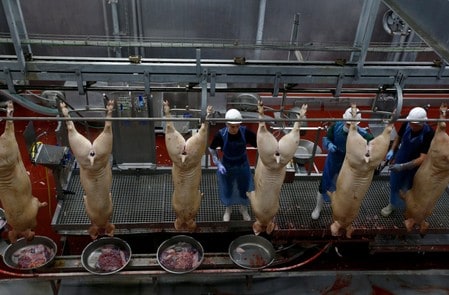By Maria Kiselyova and Olga Popova
MOSCOW (Reuters) – Russia’s pork industry is being hampered by African Swine Fever (ASF) as outbreaks of the virus are preventing producers from exporting more to lucrative Asian markets and leaving them with falling prices at home, industry experts say.
Russia first reported ASF in 2007 and has registered more than 1,300 cases since then as the highly contagious hemorrhagic disease of pigs has spread from the southern Caucasus region to the country’s northwest region and Siberia in the east.
The spread has coincided with Russian efforts to boost local production in a bid to substitute imports of European Union pork that have been banned since 2014, despite a World Trade Organization (WTO) ruling demanding the ban be lifted.
Helped by state subsidies, Russian producers now meet 95 percent of local demand. But as the amount of locally produced pork has climbed, domestic prices have slipped.
“We have come to the point where developing the sector further without significant exports becomes difficult and strategically short-sighted,” said Yuri Kovalev, head of Russia’s National Union of Swine Breeders.
One of Russia’s top three producers, Cherkizovo, said the average selling price for its products was 5.3 percent lower in the first half of 2018 than a year earlier.
The value of pork sales at Rusagro, another big producer, fell 6 percent in the first half of 2018 compared to 2017 as prices slid.
Cherkizovo and Rusagro, along with the other big producer Miratorg, together control 20 percent of Russia’s market, according to the National Union of Swine Breeders.
The three firms, which have all been affected by the virus in previous years, want to keep expanding but say ASF outbreaks are undermining their prospects abroad.
Miratorg, whose pork production growth slowed to 1.5 percent in 2017 from 6 percent in 2016, said ASF was “certainly one of the main obstacles to expanding exports and opening up new markets.”
At least 105 outbreaks have been reported in Russia in 2018, of which 55 were in farmed pigs, Russian agriculture watchdog Rosselkhoznadzor said. Wild boars can also contract the virus.
EXPORT MARKETS
Russia already sells some pork abroad, with exports climbing more than 20 percent in 2017 to more than 70,000 tonnes. But that remains a fraction of the annual global pork trade of 8 million tonnes.
“Export volumes are very small compared to the potential Miratorg and Russia have,” said Miratorg, which produced 415,000 tonnes in 2017 and has plans to double capacity by 2023.
Russia’s main export markets are former Soviet countries, with some supplies going to Africa and southeast Asia, Kovalev said.
Asia is the most attractive market, as prices there are 20-30 percent higher than in Russia, said Sergey Beiden, an analyst at Renaissance Capital.
But China, the world’s biggest consumer and producer of pork, is struggling with its own outbreak of ASF and offers limited prospects for Russian pork products for now.
Cherkizovo said it was “highly unlikely that in this environment any Russian region will obtain permission to export to China soon.”
Sergei Yushin, President of the Russian Meat Association, also said he expected China to tighten its import regulations. But he added: “We still have potential to increase (export) volumes to existing markets.”
For now, Rusagro, which has invested heavily in a pork production complex in Russia’s Far East, has said it would not expand capacity further until more export markets opened up.
Russia and China are not alone in battling the disease. Belgium reported in September its first ASF outbreak since 1985, while hundreds of thousands of pigs have already been slaughtered in Eastern Europe because of the virus.
But Kovalev said Russia’s efforts to tackle ASF could build confidence among foreign buyers of Russian pork.
Cherkizovo said it had invested more than 2 billion roubles ($30 million) to protect its pork facilities from diseases over the past two years, while Miratorg said it spends tens of millions of roubles each year on sanitary treatments.
(Editing by Edmund Blair)


